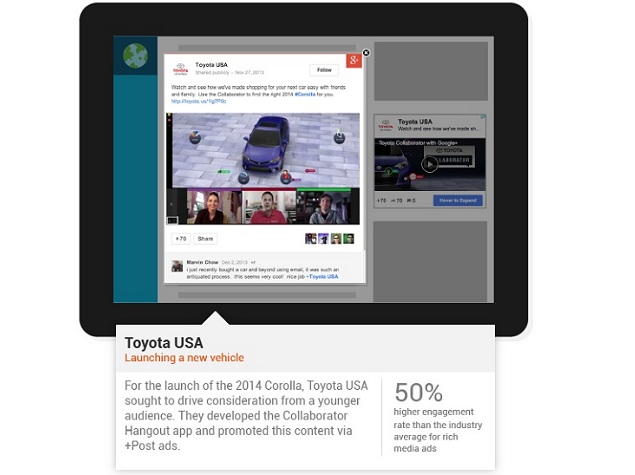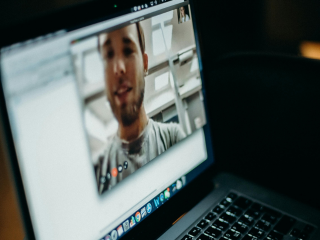- Home
- Social networking
- Social networking News
- Google now lets brands turn Google+ content into ads
Google now lets brands turn Google+ content into ads

Google on Wednesday announced that it was rolling out +Post ads to all AdWords users, a new type of monetisation feature for Google+ that can turn branded content on Google's social network into display ads. This was explained in a post by Google, which you can see here.
The company had first introduced +Post ads in December to a limited number of advertisers, testing out this new format for advertisements. As mentioned in the linked post, +Post ads allowed a brand to take a piece of their public Google+ content, like a photo, video, or even a hangout, and turn it into a display ad that can run across the Google Display Network. This move made a lot of sense since Google was seen to be struggling to win over brands, as businesses chose to be more active on Facebook and Twitter instead. By connecting a brands social presence and marketing strategy, it made Google+ a viable test-bed for content, which could then be shared across a wide network of sites.
Wednesday's announcement means that all AdWords users who meet certain minimum requirements can now make a +Post advertisement from their Google+ content. All they need is to have at least 1,000 followers on Google+ and to have opted in for shared endorsements for Google+ pages and the last requirement is that the post "should contain content that is relevant to your audience". Since the last point is a subjective measure, it will be interesting to see how this rule is enforced, though it's unlikely that a brand would want to spend money on the display network for an ad that is not relevant.
Google has also launched two new features for +Post ads - Hangouts on Air, and automatic post promotion. This will allow users to take specific actions such as RSVPing and event, watching a Hangout live, or viewing a recording after the event, and also make it easier to promote your posts, while paying only when people engage with the content.
What does this change for the end users? Not much, in all probability. It could increase brand activity on Google+, but users won't necessarily have to see the content. Instead of tweaking the feeds to increase ad visibility, by helping brands integrate their social content across the Web, Google is - for now - helping brands reach users without forcing the interaction. Whether this will actually yield results for Google+ is harder to predict.
Get your daily dose of tech news, reviews, and insights, in under 80 characters on Gadgets 360 Turbo. Connect with fellow tech lovers on our Forum. Follow us on X, Facebook, WhatsApp, Threads and Google News for instant updates. Catch all the action on our YouTube channel.
Related Stories
- Samsung Galaxy Unpacked 2025
- ChatGPT
- Redmi Note 14 Pro+
- iPhone 16
- Apple Vision Pro
- Oneplus 12
- OnePlus Nord CE 3 Lite 5G
- iPhone 13
- Xiaomi 14 Pro
- Oppo Find N3
- Tecno Spark Go (2023)
- Realme V30
- Best Phones Under 25000
- Samsung Galaxy S24 Series
- Cryptocurrency
- iQoo 12
- Samsung Galaxy S24 Ultra
- Giottus
- Samsung Galaxy Z Flip 5
- Apple 'Scary Fast'
- Housefull 5
- GoPro Hero 12 Black Review
- Invincible Season 2
- JioGlass
- HD Ready TV
- Laptop Under 50000
- Smartwatch Under 10000
- Latest Mobile Phones
- Compare Phones
- Realme P4x 5G
- OnePlus Ace 6T
- OPPO A6x 5G
- Samsung Galaxy Z TriFold
- Poco F8 Ultra
- Poco F8 Pro
- Huawei Mate 80 RS Master Edition
- Huawei Mate 80 Pro Max
- Asus ProArt P16
- MacBook Pro 14-inch (M5, 2025)
- Poco Pad M1
- Poco Pad X1
- Just Corseca Skywatch Pro
- Honor Watch X5
- Acerpure Nitro Z Series 100-inch QLED TV
- Samsung 43 Inch LED Ultra HD (4K) Smart TV (UA43UE81AFULXL)
- Asus ROG Ally
- Nintendo Switch Lite
- Haier 1.6 Ton 5 Star Inverter Split AC (HSU19G-MZAID5BN-INV)
- Haier 1.6 Ton 5 Star Inverter Split AC (HSU19G-MZAIM5BN-INV)

















